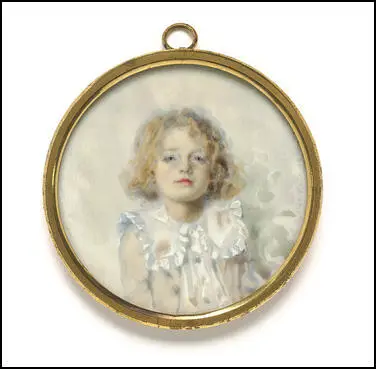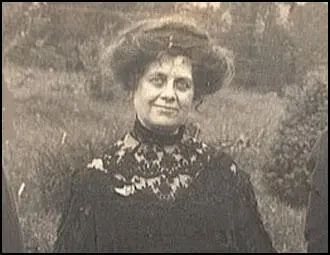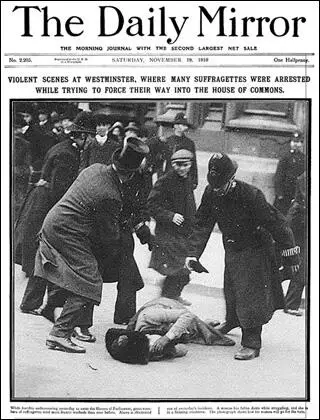Evelyn Haig
Louisa Evelyn Cotton Haig, the seventh daughter of Helen Fell Haig (1821-1876) and James Haig (1813-1891) was born in Edinburgh on 5th September 1863. Her father had been born in County Galway, Ireland, and had studied Law at Dublin University, but after he married the Scottish-born daughter of Janet and Captain Michael Edwin Fell, an army officer, in Edinburgh in 1848, he had made his home in Scotland. As a Barrister-at-Law at London's Lincoln's Inn, James Haig also maintained a home in London. (1)
Evelyn Haig was the sister of Florence Haig and Cecilia Haig, and the cousin of Margaret Haig Thomas. (2) She was also the cousin of Douglas Haig who during the First World War would be promoted to the rank of Field Marshall and commander in chief of the British Expeditionary Force. (3) It was also claimed that Henry Orator Hunt, who was imprisoned for 18 months for supporting universal suffrage at the Peterloo Massacre in 1819 was her grand-uncle. (4)
In 1881 Evelyn Haig was recorded as being at a boarding pupil/scholar at the Misses Templer's Young Ladies' School at 13 Arundel Terrace, Brighton. (5) At the time of the 1891 census, Evelyn Haig was visiting the family home of Frederick William Furley, a "Banker", at Sunbury House, New Road, Canterbury, Kent. (6)
Evelyn Haig: Artist
Evelyn Haig became an artist, specialising in miniatures, studied in Paris and exhibited at the Paris Salon. (7) She exhibited at the Royal Academy between 1891 and 1897. (8) Her painting Innocence (1900) was described by The Times as "very charming… with great freedom." The Auckland Star pointed out that "'Innocence was... simple and very beautiful… with a broadness of treatment which is refreshing." (9)

Evelyn Haig was also interested in politics and in 1901 she became an active member of the Edinburgh Ladies' Debating Society in 1901. (10) At that time she was living at 87 Comely Bank Avenue, Edinburgh, Scotland. (11)
Women's Social and Political Union
Helen Fraser joined the Women Social & Political Union in 1906 after hearing a speech made by Teresa Billington-Greig. Fraser became treasurer of the Glasgow branch of the WSPU and was appointed as organiser of Scotland. (12)

Two of her older sisters, Florence Haig and Cecilia Haig, were supporters of women's suffrage and had been members of the National Union of Women's Suffrage Societies but in 1907 they joined the WSPU. According to Votes for Women, her sisters persuaded her to become a member and they established a WSPU branch in Edinburgh. (13) Helen Fraser appointed Evelyn Haig as honorary treasurer of the Edinburgh branch. (14)
The Conciliation Bill
The Conciliation Bill was designed to conciliate the suffragist movement by giving a limited number of women the vote, according to their property holdings and marital status. After a two-day debate in July 1910, the Conciliation Bill was carried by 109 votes and it was agreed to send it away to be amended by a House of Commons committee. However, when Keir Hardie, the leader of the Labour Party, requested two hours to discuss the Conciliation Bill, H. H. Asquith made it clear that he intended to shelve it. (15)
Emmeline Pankhurst was furious at what she saw as Asquith's betrayal and on 18th November, 1910, arranged to lead 300 women from a pre-arranged meeting at the Caxton Hall to the House of Commons. Pankhurst and a small group of WSPU members, were allowed into the building but Asquith refused to see them. Women, in "detachments of twelve" marched forward but were attacked by the police. (16)
Evelyn and her two sisters, Florence Haig and Cecilia Haig took part in the demonstration. Several women reported that the police dragged women down the side streets. "We knew this always meant greater ill-usage.... The police snatched the flags, tore them to shreds, and smashed the sticks, struck the women with fists and knees, knocked them down, some even kicked them, then dragged them up, carried them a few paces and flung them into the crowd of sightseers." (17)

Cecilia Haig was one of those who received a beating from the police. As the Votes for Women pointed out: "Miss Haig was entirely unaware of the presence of any illness, and, indeed, felt quite well. But on Black Friday, she was not only subjected to assault of a most disgraceful kind, but was also trampled upon." Her sisters nursed her but Cecilia died on 31st November 1911. (18)
Sylvia Pankhurst claimed that she died because of the beatings they endured that day. "I saw Celilia Haig go out with the rest; a tall, strongly built, reserved woman, comfortably situated, who in ordinary circumstances might have gone through life without receiving an insult, much less a blow. She was assaulted with violence and indecency, and died in December 1911, after a painful illness, arising from her injuries." (19)
In January 1913 Evelyn Haig and Margaret Macfarlane were arrested and charged with obstruction after taking part in a protest outside the House of Commons against the withdrawal of the Franchise Bill. (20) Both women were sentenced to one month in Holoway Prison. (21)
Later Life
A 1930 Street Directory records Evelyn Haig, residing alongside sister Florence Haig at 4 Trafalgar Studios, Manresa Road, near the King's Road, Chelsea, London, SW3. However, by 1933 the two sisters moved to Flat 7 Stafford House, Maida Ave, Paddington, London W2. (22)
Louisa Evelyn Cotton Haig of 21 West Side, Clapham Common, London SW4 died on 2nd February 1954 at the home of Florence Haig. In her will she left effects valued at £10,019.10s.
Primary Sources
(1) Tim Jones, Innocence by Evelyn Haig (25th May 2016)
This miniature painting, just 7 centimetres across, came to New Zealand in 1906. It was displayed in the British art section of the New Zealand International Exhibition and was among the works that the Canterbury Society of Arts purchased from that show for the city. The CSA minutes of 7 December 1906 record that eight guineas were set aside for this purchase. Historical value comparisons are notoriously tricky, but we might estimate that to be worth about $500 today. 'In the Wizard's Garden', a large oil painting, cost £200.
The subject matter is sweet-toothed by today's standards but it is expertly painted in oil on ivory and any idea that the artist may have matched the stereotype of the shrinking female Victorian painter of domestic miniatures can be soundly rejected.
Evelyn Cotton Haig was born in 1863 in Edinburgh, the daughter of a barrister and was one of three sisters. She studied art in Paris and exhibited at the Paris Salon and the Royal Academy. She and her sisters Cecilia and Florence were founding members of the Edinburgh branch of the Women's Social and Political Union.
ll three were in other words active suffragettes. The eldest, Cecilia, was trampled and injured in a women's suffrage protest in Parliament Square in November 1910. Her death a year later was as a result of the injuries received that day. All three sisters were arrested at this protest by policemen described as 'the roughest, most bloated-looking people' ever seen. This description comes from Anna Stout, wife of New Zealand's Chief Justice Sir Robert Stout and herself an advocate of women's suffrage, who was in London at the time and witnessed the messy scene.
Evelyn, the artist, was hauled before the magistrates at Bow Street court and released. She made a second appearance there in January 1913, again following a protest outside parliament, but this time she was convicted of obstruction and sent to Holloway Prison for a month. The third sister, Florence, a leading suffragette, spent three months in prison in 1908, and four months in 1913, this time for smashing the windows of D H Evans department store in Oxford Street. She was a pall-bearer at Emily Pankhurst's funeral in 1928.
It is possible that our work was exhibited at the Society of Miniature Painters in 1900, where Evelyn Haig's depictions of heads were described by 'The Times' as 'very charming…with great freedom.' An unnamed Auckland Star reviewer thought 'Innocence' was '…simple…and very beautiful…with a broadness of treatment which is refreshing.' Christchurch exhibition organizer Alfred Longden said 'There is an especially good show of miniatures - one of the best ever sent out of Britain. Personally I consider it to be the best'.
There is one other telling mention of Evelyn Haig in 'The Times': in 1938 she donated £5 to Lord Baldwin's Refugee Fund. Amongst the donations listed on the same page is one of £300 from Otto Frankel, scientist and husband of Christchurch artist and 'Pleasure Garden' activist Margaret Frankel. Everything, it seems, is linked to everything.
(2) Votes for Women (14th May 1908)
For the purpose of opening the Edinburgh and Mid-Lothian Branch of the Scottish Women's Social and Political Union, an "At Home" was held in the Oak Hall of the Edinburgh Café, Princess Street, recently. Mrs John Hunter, Glasgow, presided over a large gathering, including Mrs Gibson, wife of the Lord Provost, Miss Helen Fraser, organising secretary; Miss Methven, Mrs Burn Murdoch and Miss McMillan…
Mrs Hunter congratulated the meeting on the formation of a branch in Edinburgh, and urged the ladies present not to be deterred from taking an interest in this movement by ridicule. As a mother she wanted to say very strongly that this movement had her support, because if the status of women was raised so was the status of man… To her mind the movement was a moral one, and there was nothing ridiculous about it. Miss Esson Maule, honorary secretary, and Miss Evelyn Cotton Haig, honorary treasurer, reported briefly on the progress of the branch, the former stating that they had secured rooms in the Albert Buildings, Shadwick Place, as offices and headquarters.
(3) Votes for Women (25th November 1910)
Miss Cecilia Wolsey Haig of Edinburgh is a member of a well-known Berwickshire family, and spent many years doing social work. Her parents were both in favour of Women's Suffrage, and a grand-uncle of hers suffered eighteen months' imprisonment in 1819 for a speech in favour of suffrage reform. She has helped indefatigably in election work. The two imprisonments of her sister, Miss Florence Haig, made her see that if all helped the end would be won.
Miss Evelyn Cotton Haig, daughter of James Haig, daughter James Haig, barrister-in-law, is an artist, studied in Edinburgh and Paris, and has exhibited in the Paris Salos, Royal Academy, and elsewhere. She was brought into the movement through her sister, Miss Florence Haig. She has done a great deal of by-election and other voluntary work for the Union. She and her sister were among the five women who originally started the Scottish WSPU in Edinburgh in 1908.
(4) David Simkin, Family History Research (9th May, 2023)
Louisa Evelyn Cotton Haig (1863–1954). Born Edinburgh, Scotland. Died unmarried. Studied Art in Paris. Worked as an artist under the name of Evelyn Cotton Haig. Exhibited at the Royal Academy between 1891 and 1897. Miniature Portrait Painter. Exhibited a painting entitled "Winter's Children".
Louisa Evelyn Cotton Haig born 5th September 1863 in Edinburgh - died 2nd February 1954, Wandsworth, London.
In 1871 Census: Louisa Evelyn Cotton Haig , 7-year-old living with her family (parents and siblings) at the house of Great Aunt, Margaret Haig, at 16 Lansdowne Crescent, Edinburgh, Scotland.
1881 Census : Louisa Evelyn Cotton Haig recorded as a boarding pupil/scholar at the Misses Templer's Young Ladies' School at 13 Arundel Terrace, Brighton.
Alpina Templer, age 49 Head Principal Of Girls School (Mistress)
Emily A. Templer, age 46 Sister Principal Of Girls School (Mistress)
Laura Templer, age 43 Sister Principal Of Girls School (Mistress)
Louisa E. C. Haig, age 17, boarder, Scholar
Registration district Brighton, Sub registration district Kemp TownAt the time of the 1891 census, Louisa Evelyn Cotton Haig (described on the census return as "Artist, Figure Painter", aged 27) was visiting the family home of Frederick William Furley, a "Banker", at Sunbury House, New Road, Canterbury, Kent.
1901 Census: (Louisa) Evelyn Cotton Haig (described on the census return as "Living on Own Means", aged 37) was residing alongside her older sister, Cecilia Wolseley Haig, at a house in Edinburgh, Scotland.
In Edinburgh Electoral Roll for 1903-1904 Miss Louisa Evelyn Cotton Haig recorded as a 'Miniature Painter'
at 87 Comely Bank Avenue, Edinburgh, Scotland
Occupation: Miniature PainterA 1930 Street Directory records Miss E. Cotton Haig, residing alongside sister Miss Florence Haig RBA artist at
4 Trafalgar Studios, Manresa Road, near the King's Road, Chelsea, London, SW3.1933 Electoral Register: Evelyn Cotton Haig recorded at Flat 7 Stafford House, Maida Ave, Paddington, London W2 alongside her sister Miss Florence Eliza Haig
1939 General Register
Address Flat 7 Stafford House, Maida Ave, Paddington, London W2
Occupation: Artist (Retired)Louisa Evelyn Cotton Haig of 21 West Side, Clapham Common, London SW4 died on 2nd February 1954 at 7 Westover Road, Wandsworth Common, London SW18. (same address details as in Florence Haig's probate record)
Effects valued at £10,019. 10s

